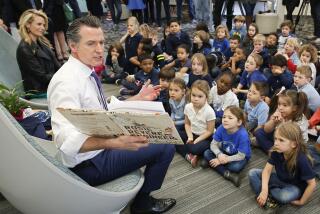The Key to Teaching Reluctant Readers
- Share via
Kylene Beers has talked about the evils of aliteracy for so long and so loud, she’s losing her voice. Today she’s in a lecture hall, bending the ears of 100 or so middle-school teachers.
One of the few academics who have written about the phenomenon, Beers, a professor of reading at the University of Houston, says there are two types of reading: efferent and aesthetic.
Efferent, which comes from the Latin word efferre (meaning “to carry away”), is purposeful reading, the kind students are taught day after day in schools. Efferent readers connect cognitively with the words and plan to take something useful from it--such as answers for a test.
Aesthetic is reading for the sheer bliss of it--as when you dive deep into Dostoevski or get lost in Louisa May Alcott. Aesthetic readers connect emotionally to the story. Beers believes more students must be shown the marvels of reading for pleasure.
On this afternoon, she’s mapping out strategies for teachers who hope to engage reluctant middle-school readers. Teaching grammar and parts of speech, such as dangling participles, is the kiss of death, she says. “You don’t want to talk about dangling anythings with middle-schoolers,” she says in her Texas drawl. And the room laughs.
Aliterate people just don’t get it. Unlike accomplished readers, aliterates don’t understand that sometimes you must read efferently and sometimes you must read aesthetically; that even the best readers occasionally read the same paragraph over and over to understand it; and that to be a good reader, you must visualize the text.
To engage nonreading students, she proposes reading strategies such as turning a chapter of a difficult book into a dramatic production or relating tough words to easier words.
She writes the word “tepid,” then she asks the audience to supply other words that describe water temperature. “Hot,” someone calls out. “Freezing,” somebody else says. Others suggest “cold,” “warm” and “boiling.”
Beers arranges the words in a linear fashion, from the coldest word, “freezing,” to the hottest, “boiling.” “Tepid” falls in the middle of the list. This method, she says, will help reluctant readers to connect words they don’t know to words they do know.
“Aliterates,” she tells the teachers, “don’t see relationships.”
Apparently, teachers don’t always see the relationships either. Author Jim Trelease is concerned that teachers do not read: The aliteracy rate among teachers is about the same, 50%, as among the general public.
More to Read
Sign up for our Book Club newsletter
Get the latest news, events and more from the Los Angeles Times Book Club, and help us get L.A. reading and talking.
You may occasionally receive promotional content from the Los Angeles Times.








